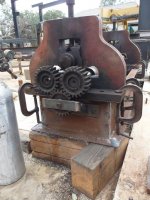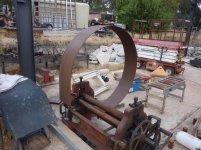Rob F.
Diamond
- Joined
- Aug 5, 2012
- Location
- California, Central Coast
I have an old pyramid type plate/sheet roller that needs to have a motor added back on to it. I got it with no motor. It is 42" wide and rolls will open up pretty wide, maybe 1 1/2" or more.Top roll is 3 1/2" and bottom rolls are 3 1/4+" (3.28"), spaced 6" c-c apart.
It has gear reduction coming into it driven by what looks like a #2 morse taper driving a 16 tooth gear, this goes to a 72 tooth connected on same shaft to a 25 tooth driving another 72 tooth gear that spins one of the lower rollers. Lower rollers are geared together on the other end. Total reduction is 12.96 if I did the math right. Would this have been driven by a large hand drill? I dont know that I have seen a hand drill with a MT instead of chuck but...
I am wanting to get this back to working so need to put a motor on it but am not sure the HP & RPM needed. I am thinking the capacity might be full width of 1/8 or 3/16? No modern machines with specs I could find were similar in roll size/width.
I appreciate any help and or suggestions.



It has gear reduction coming into it driven by what looks like a #2 morse taper driving a 16 tooth gear, this goes to a 72 tooth connected on same shaft to a 25 tooth driving another 72 tooth gear that spins one of the lower rollers. Lower rollers are geared together on the other end. Total reduction is 12.96 if I did the math right. Would this have been driven by a large hand drill? I dont know that I have seen a hand drill with a MT instead of chuck but...
I am wanting to get this back to working so need to put a motor on it but am not sure the HP & RPM needed. I am thinking the capacity might be full width of 1/8 or 3/16? No modern machines with specs I could find were similar in roll size/width.
I appreciate any help and or suggestions.





 . I had an old handcrank sitting around that had a hole in it a little bigger than the morse taper drive on the input gear. I turned a piece of tubing to fit over the morse taper and inside the hand crank, it is driven by 2 SHCS.
. I had an old handcrank sitting around that had a hole in it a little bigger than the morse taper drive on the input gear. I turned a piece of tubing to fit over the morse taper and inside the hand crank, it is driven by 2 SHCS.








